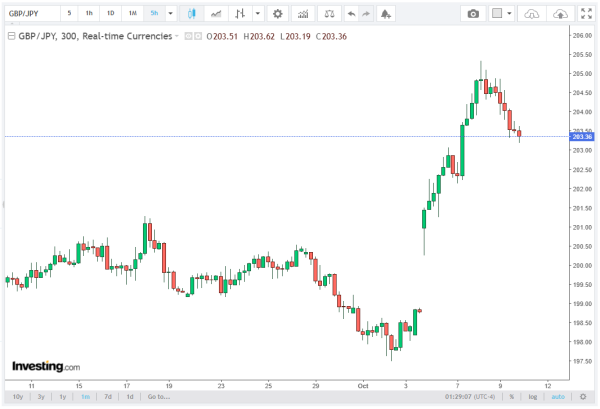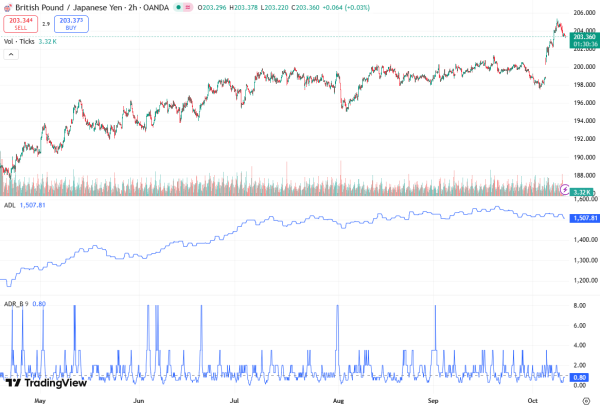The GBP/JPY pair continued its retracement from multi-month highs, losing some upward momentum amid renewed Japanese Yen (JPY) strength driven by verbal intervention and evolving Bank of Japan (BoJ) policy expectations.
Despite the pullback, the cross remains supported above the 203.00 handle, reflecting underlying British Pound (GBP) resilience and diverging monetary policy outlooks between the BoJ and the Bank of England (BoE). The Logirium team presents a structured and thoughtful breakdown of this matter.
GBP/JPY Extends Weekly Correction
The GBP/JPY cross faced follow-through selling pressure on Friday, marking its second consecutive day of decline after touching its highest level since July 2024, around 205.30 earlier this week.
As of writing, the pair trades near 203.25, down roughly 0.20% on the day, although it remains poised for weekly gains. The recent correction comes as traders reassess Japan’s political and fiscal landscape following Sanae Takaichi’s leadership victory in the Liberal Democratic Party (LDP).
Market participants interpreted Takaichi’s win as a potential signal for expansionary fiscal policy, a stance that initially weighed on the JPY due to assumptions of continued monetary accommodation. However, her subsequent comments, together with remarks from Japanese officials, helped temper JPY losses and triggered a near-term pullback in GBP/JPY.
Verbal Intervention Revives Yen Demand
The JPY found renewed strength after Japan’s Finance Minister Shunichi Kato emphasized the need for currency stability, stating that authorities are prepared to monitor and respond to excessive fluctuations or disorderly market movements.
Such verbal intervention often serves as a warning to speculative traders betting against the Yen, and it provides a short-term boost to the currency.
Moreover, Prime Minister-elect Takaichi commented that she does not wish to trigger excessive declines in the Yen, adding further weight to the government’s message. These statements collectively acted as a psychological defense against rapid JPY depreciation and curbed the bullish momentum of GBP/JPY, at least temporarily.

BoJ Policy Outlook: Balancing Inflation and Stability
Beyond verbal signals, investors are closely monitoring the evolving BoJ policy outlook under Japan’s incoming administration. Economic advisors to Takaichi, such as Etsuro Honda and Takuji Aida, have indicated potential tolerance for another rate hike either in December or January, contingent on sustained inflation and growth metrics.
Japan’s core inflation has remained at or above the BoJ’s 2% target for more than three years, while the economy expanded for a fifth consecutive quarter through June. These data points strengthen the argument for gradual policy normalization, even as policymakers remain wary of excessive currency volatility.
BoE Policy Expectations Underpin the Pound
While the BoJ grapples with policy normalization, the BoE faces a different challenge, managing sticky inflation while avoiding a sharp economic slowdown. Market participants increasingly believe that the BoE will maintain interest rates at 4% through the remainder of 2025, as recent data show persistent inflationary pressures and resilient labor market conditions.

This stance contrasts with earlier expectations for rate cuts, reducing downward pressure on the GBP. Consequently, the interest rate differential between Japan and the UK continues to favor the Pound, even as near-term corrective moves persist.
The perception that the BoE is likely to delay policy easing helps anchor the GBP/JPY cross above 203.00, suggesting that traders view this level as a short-term support zone.
Technical Outlook: Holding Key Levels
From a technical analysis perspective, the GBP/JPY pair remains in a broader uptrend, despite recent declines. The correction from 205.30 toward 203.00 represents a healthy consolidation within a bullish channel. The 203.00–202.80 region offers initial support, coinciding with the 50-period moving average on the four-hour chart.
A sustained break below 202.80 could expose the pair to further downside toward 202.00, while on the upside, 204.50 and 205.30 remain key resistance levels. Momentum indicators such as the Relative Strength Index (RSI) show a mild pullback from overbought territory, suggesting limited selling pressure unless broader fundamentals shift significantly.
Outlook: Policy Divergence Still in Focus
Looking ahead, the GBP/JPY trajectory will likely hinge on policy divergence between the BoE and BoJ, as well as the tone of official communications from Japanese authorities. If the BoJ signals readiness for additional tightening, the JPY could extend gains. Conversely, any signs of BoE hawkishness may quickly restore upward momentum in the cross.
In the near term, traders will closely watch upcoming BoE and BoJ meetings, UK CPI data, and further comments from Japanese policymakers for fresh cues. Until then, GBP/JPY may continue oscillating around the 203.00–204.50 band, balancing verbal intervention-driven JPY strength against GBP’s fundamental support.









